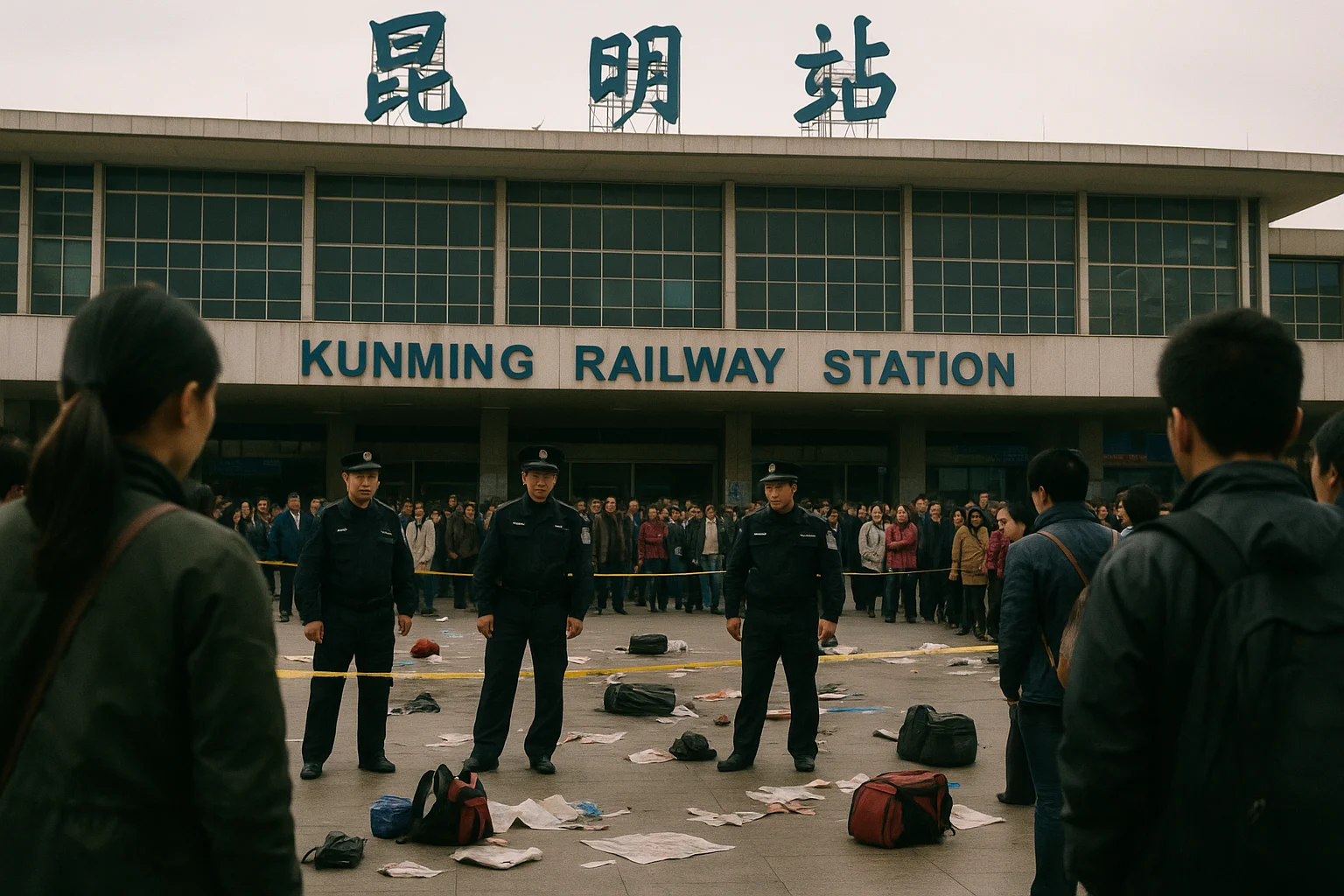
The 2014 Kunming Train Station Attack
by: The Calamity Calendar Team
March 1, 2014
A Dark Night in Kunming
As March 1, 2014, wound down, the bustling Kunming Railway Station in China's Yunnan Province was alive with its usual symphony of announcements, footsteps, and the shuffle of travelers intent on their destinations. It was a space brimming with the everyday noise of life paused briefly for passengers on their way to the next leg of their journey. No one could have imagined that, within moments, this regular Saturday would erupt in unimaginable chaos.
Underlying Strains
China, in the years leading up to this night, was a nation grappling with internal tensions, particularly in its far-western region of Xinjiang. Home to the Uyghur ethnic minority, Xinjiang had become a hotbed of unrest. Many Uyghurs, feeling the weight of cultural suppression and economic negligence, saw their dreams of autonomy clash violently against Beijing’s firm administrative grip. This friction was not new—it simmered and occasionally sparked for decades—but for those in Kunming, the trouble always seemed a world away.
Yet this night, that distant tension leapt into stark, sudden focus within the walls of the railway station, far from Xinjiang's borders.
The Attack Begins
The night chilled over Kunming as a group of assailants loitered on the periphery of the train station, blending into the obscurity offered by the busy night. At precisely what time these attackers emerged from shadows to action is a detail blurred by the flurry of events, but close to 21:20 marks the onset of horror.
Without warning, armed with long knives, the attackers descended upon innocuous commuters, their manner indiscriminate, their intent unmistakably malicious. The panic spread like wildfire—a cacophony of screams resonated through the station as bystanders scrambled to evade the looming threat. For many trapped amidst the chaos, the serene night had turned into a nightmare.
The dispatch of emergency services was near-instantaneous, yet even within those quick minutes, the damage was catastrophic. Police rushed into the fray, weapons drawn as they attempted to stem the tide of violence.
Thanks for subscribing!
Aftermath of Carnage
The attack’s toll was catastrophic. Thirty-one lives were lost—tragedy etched into the heart of the city. More than 140 people were left counting their injuries, both physical and psychological. It was a wound on a community, a country, struggling to reconcile with the brutality experienced.
Kunming, known for its tranquility and as a gateway to scenic destinations, found itself engulfed in a global media storm. The images of security services shielding shocked survivors and disarrayed bags littering the station became emblematic of an incident that shook the nation.
Economic repercussions rippled outward, pressing down on tourism sectors and unsettling regional commerce as fear cloaked potential visitors and citizens alike.
The Nation Responds
The Chinese government met the attack with swift condemnation, labeling it an act of terrorism, indicting the suspected motives tied to separatist intentions. It vowed to counteract such violence with increased military readiness and strategic legislative changes. Security tightened across the country, a taut reminder of the nation’s resolve against similar future violence.
Kunming's psychological recovery required a meticulous approach—a blend of mourning and solidarity, of remembrance and renewed vigilance. In institutions like the railway stations, broader surveillance measures emerged, along with a persistent, pervasive sense of watchfulness.
Echoes and Reflection
In the aftermath's stillness, investigations bore down on uncovering the layers beneath the brutal act. Captured assailants brought into custody, their trials cast a spotlight upon China's legal procedures amid cries from international quarters over the fairness extended to Uyghur defendants. When the courtroom doors closed, the sentences passed were final for many, their futures sealed by the swift justice handed down.
Though time wore on, the attack at Kunming remains etched in China’s contemporary history—a pointed example of the country’s ethnic rifts.
Understanding the Broader Picture
Today, the motives behind the Kunming attack are still the subject of debate amongst scholars, politicians, and activists. For some, it exemplifies an excruciating cry for attention to the ethnic plight within Xinjiang. Others align with the narrative of militant extremism, defended by the need for stringent security in the face of domestic terrorism.
The dialogue on these events stresses the intricate dance between modern governance and ethnic rights within the expanding tapestry that constitutes China. These violent moments are not mere tragedies but clarion calls for deeper engagement, conversation, and reform.
Stay in the Loop!
Become a Calamity Insider and get exclusive Calamity Calendar updates delivered straight to your inbox.
Thanks! You're now subscribed.